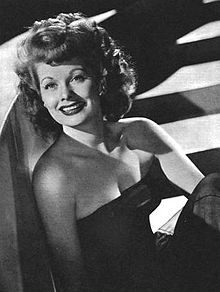Lucille Ball
Lucille Désirée Ball (born August 6, 1911 in Jamestown , New York , † April 26, 1989 in Beverly Hills , California ) was an American actress and film and television producer. After starting out as a supporting actress in Hollywood in the 1930s and 1940s, she became one of America's most popular television comedians as the star of the television show I Love Lucy in the 1950s .
Life
After the death of her father Henry Durrell Ball (1887-1915), Lucille Ball was raised by her working mother Desirée Eveline Hunt (1892-1977) and her grandparents. She moved to New York to become an actress, and had some success as a model and chorus girl. In 1933 she went to Hollywood to start a film career. In the 1930s she was under contract with RKO and played many small roles, including in Room Service with the Marx Brothers , but also leading roles, such as in Next Time I Marry . She moved to MGM in the 1940s , but never had much success in film. In Hollywood circles she was known as the " B-Movie Queen" (with Macdonald Carey as her "King"). While filming the film adaptation of the musical Too Many Girls , she met Desi Arnaz and married him. The couple had two children: Lucie Arnaz and Desi Arnaz Jr.
In 1948, she was cast as the slightly insane wife on My Favorite Husband , a radio show. The show was successful and CBS asked it to develop into a television show. She consented but insisted on working with her husband Desi Arnaz. The television show I Love Lucy was born.
I Love Lucy was not only a star vehicle for Lucille Ball, but also an attempt to save her marriage to Desi Arnaz, who suffered from their hectic schedules. As a side effect, she practically invented the sitcom and was one of the first stars to film with a live audience.
The show was recorded directly on film material, unlike most other television programs of the time, which filmed images on a television monitor using the inferior kinescope method. The better quality of the Lucy show made it possible to repeat it by syndication (on independent television stations that do not belong to one of the major television networks ABC, CBS or NBC). During the production of I Love Lucy , the German cameraman Karl Freund invented the “3-camera setup”, which is now standard on television. Another unusual technique used on the Lucy Show was painting over unwanted shadows and covering up lighting defects with paint that was kept in the studio in various shades from white to medium gray for this purpose.
On I Love Lucy (1951-1957) sequels followed The Lucy-Desi Comedy Hour (1957-1960) and The Lucy Show (1962-1968), later in Here's Lucy was renamed (1968-1974). Some episodes ran under the title Hoppla Lucy 1971/72 on ZDF . Another television show, Life with Lucy , flopped with critics and viewers alike in 1986.
Together with her husband Desi Arnaz, Lucille Ball founded the Desilu Productions studio in Hollywood , making her the first woman to own a Hollywood studio (even if it didn't produce films, but TV shows). In 1956 Desilu bought the RKO site and moved there. In 1960, Lucille Ball and Desi Arnaz were divorced after Arnaz had problems with alcohol, drugs and other women. Lucille Ball bought his stake and was the sole owner of the studio. In the following years Desilu developed, among other things, the well-known television series Star Trek and Kobra, take over . In 1967 Desilu was sold to Gulf and Western Industries , which Desilu merged with the Paramount studios (located on the property next to it).
death
Lucille Ball died of aortic dissection at the age of 77. She was buried in Forest Lawn - Hollywood Hills Cemetery , Los Angeles , but was later buried by her children, Desi Arnaz Jr. and Lucie Arnaz, reburied in Lake View Cemetery in their native Jamestown.
Filmography (selection)
- 1934: The Affairs of Cellini
- 1934: Broadway Bill
- 1935: Talk of the Town (The Whole Town's Talking)
- 1935: I Dream Too Much
- 1936: That Girl from Paris
- 1936: winter set
- 1936: Dummy Ache
- 1936: Navy Against Lovesickness (Follow the Fleet)
- 1938: Joy of Living
- 1937: Stage Door (Stage Door)
- 1938: Next Time I Marry
- 1938: Room Service
- 1940: Dance Girl Dance
- 1943: You Barry Was a Lady
- 1945: Too Smart for Love (Without Love)
- 1945: Broadway Melody 1950 (Ziegfeld Follies)
- 1946: Enemy in the Dark (The Dark Corner)
- 1947: Lured ( Lured )
- 1953: Villa with 100 hp (The Long, Long Trailer)
- 1960: Such an Affair (The Facts of Life)
- 1963: Don't do that, Angelika (Critic's Choice)
- 1968: Yours, Mine and Ours (Yours, Mine and Ours)
- 1974: Mame
literature
- Susan Horowitz: Queens of Comedy. Lucille Ball, Phyllis Diller, Carol Burnett, Joan Rivers and the New Generation of Funny Women (= Studies in Humor and Gender . Volume 2 ). Gordon and Breach, Amsterdam et al. 1997, ISBN 2-88449-243-7 , pp. 21st ff . (English, limited preview in Google Book Search).
Web links
- Lucille Ball in the Internet Movie Database (English)
- Images by Lucille Ball In: Virtual History
- Biography, literature & sources for Lucille Ball FemBio from the Institute for Women's Biography Research
- Lucille Ball in the database of Find a Grave (English)
| personal data | |
|---|---|
| SURNAME | Ball, Lucille |
| ALTERNATIVE NAMES | Ball, Lucille Desirée; Arnaz, Lucille; Morton, Lucille |
| BRIEF DESCRIPTION | US-american actress |
| DATE OF BIRTH | August 6, 1911 |
| PLACE OF BIRTH | Jamestown |
| DATE OF DEATH | April 26, 1989 |
| Place of death | Beverly Hills |

